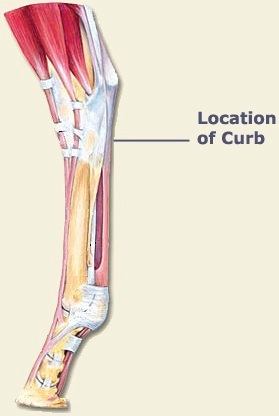|

For an excellent article on curb: Curb
Curb is defined in older literature as enlargement secondary to inflammation and thickening of the long plantar ligament in horses. However, with the widespread use of diagnostic ultrasonography in equine medicine, curb has been redefined as a collection of soft tissue injuries of the distal plantar hock region. Curb is a useful descriptive term when describing swelling in this area.
Structures Affected
Besides swelling in the long plantar ligament, injury to the deep digital flexor tendon, superficial digital flexor tendon, tarsocrural lateral collateral ligament or peritendonous/periligamentous tissues in this region can contribute to the appearance of curb. Sickle-hocked conformation is a predisposing risk factor for the development of curb. Among the breeds Standardbreds are the most prone to curb due to poor (sickle-hocked) conformation. It is a predisposing factor.
Sickle- or Sabre-Hocked/ Overangulated Long Hind Legs
The hind leg slants forward, in front of the plumb line, when viewed from the side. The cannon is unable to be put in vertical position. Also called "curby" hock, as it is associated with soft tissue injury in the rear, lower part of the hock. Limits the straightening and backward extension of hocks, which this limits push-off, propulsion, and speed. There is overall more hock and stifle stress. Closed angulation and loading on the back of the hock predisposes the horse to bone and bog spavin, thoroughpin, and curb.
Fluid accumulation and/or swelling are almost always found in the peritendonous/periligamentous tissues in curb, often with no additional underlying injuries. Injury to the superficial digital flexor tendon as a cause of curb is as common as injury to the long plantar ligament. Injury to the deep digital flexor tendon as a cause of curb is less common, and collateral ligament desmitis in the tarsocrural joint is uncommon. Combination of injury to the long plantar ligament and tendon of the gastrocnemius is also seen.
Diagnosis
Curb as a visible blemish is an easy diagnosis, as swelling in the distal lateral hock region is, by definition, curb. However, ultrasound is an essential tool in the diagnosis and in establishing a treatment plan. Diagnostic anesthesia (local or nerve blocks) can be helpful, but is not perfectly specific in this area.
Treatment
Curb is treated similarly to chronic desmitis (ligament inflammation). Treatment generally consists of stall rest and topical therapy. Also, extracorporeal shock wave therapy (ESWT) has been helpful. A controlled exercise program based on clinical and ultrasound findings has proven to be very effective at hastening resolution of curb. Many other treatments related to tendon and ligament injuries have been tried.
For More Information:
Tendon Sheath Effusion, Tenosynovitis
Horse Tendons and Ligaments
|